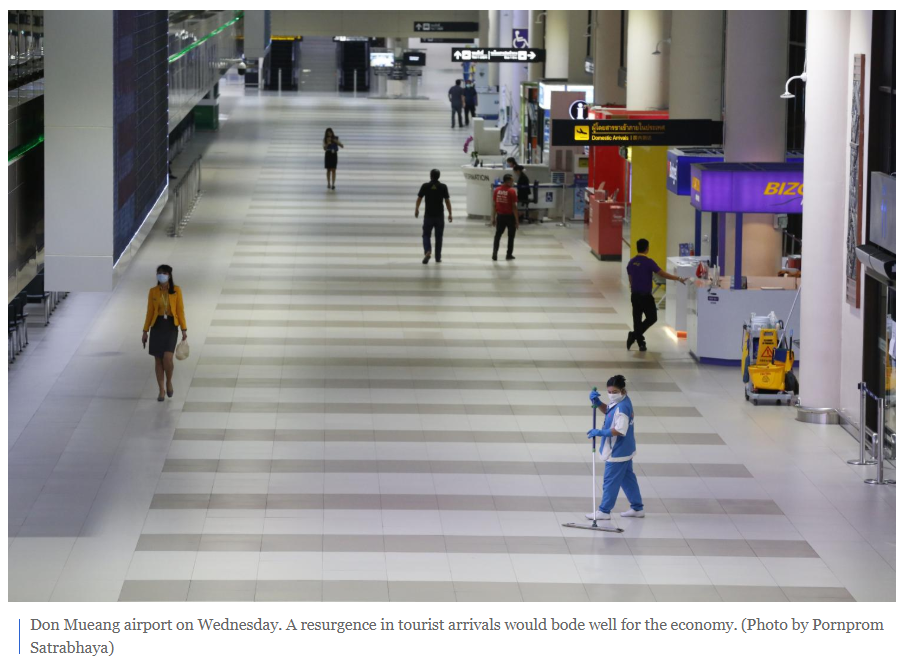Thailand: BoT outlines possible recovery paths
The economy is likely to stage a V- or U-shaped recovery, while a W-shaped rebound is not far-fetched if a second wave of coronavirus occurs, says a senior official at the central bank.
The V- or U-shaped recovery mainly depends on foreign tourist arrivals and the global economy, said Don Nakornthab, who is in charge of the economic and policy department at the central bank. Foreign arrivals are not expected to return rapidly, given lockdown policies worldwide and in Thailand.
“Even though the government is beginning to allow some local businesses to reopen, cross-border transport remains shut to contain the spread,” Mr Don said.
Some economists estimate that the global economy could post a W-shaped recovery because of a second wave of the outbreak. To prevent such an occurrence, coronavirus policies require close monitoring, Mr Don said.
A V-shaped recovery involves a steep fall in the economy followed by a sharp rise back to the previous peak, while a U-shaped pattern is marked by a slump and an extended period in the trench before a rebound. A W-shaped trajectory is also called a double-dip recession.
In March, the Bank of Thailand forecast a 5.3% contraction for 2020, compared with 2.8% growth predicted previously.
Mr Don said the economic contraction deepened in March from the previous month.
The outbreak dealt a greater blow in March to economic activities from all angles, particularly the tourism sector, than in the preceding month, due to bans on inbound tourists imposed by Thailand and many other countries.
The number of foreign tourist arrivals in March was 819,000, down 76.4% from last year, and the impact will be larger in April.
Among economic indicators, only public spending grew for the first time in five months in March, thanks to disbursement after the enactment of the fiscal 2020 budget.
“The measures announced in April are sizeable,” Mr Don said. “Public funds must be spent in a timely manner and towards the right targets. If measures are inadequate, related parties must be ready to increase [the budget].”
The government launched a 1.9-trillion-baht package, marking the biggest relief measure ever, to soften the economic blow.
Of the total, 1 trillion baht is for cash handouts to virus-hit people and farmers, public healthcare expenditure and economic and social rehabilitation; 500 billion baht is for the central bank’s soft loan scheme for small and medium-sized enterprises (SMEs) with credit lines of up to 500 million baht; and 400 billion baht is for the Corporate Bond Stabilisation Fund.
Mr Don said the 1-trillion-baht relief plan is equal to 6% of GDP, while the 500 billion baht in soft loans represents 3%.
The central bank’s soft loan scheme will help support liquidity of SMEs and needs to monitor loan demand after a mere 24 billion baht in loans were sought in the first week after the application period opened.
On the stability front, some indicators deteriorated, with headline inflation plunging into negative territory for the first time since June 2017 in March on a sharp contraction in energy prices. The labour market became more vulnerable, Mr Don said.
The current account registered a narrow surplus, owing to a lower trade balance from the increase in merchandise import value and the decline in travel receipts.
The capital and financial accounts posted a deficit from both the asset and the liability positions. Overall stability remained sound, however.
The baht weakened against the dollar from March to the beginning of April, but the trend later reversed as the US reported that new coronavirus cases were under control, Mr Don said, adding that there is no rapid recovery for tourism in sight to reset the local currency’s longer trend.
He said economic growth is expected to shrink in the first quarter, with a deeper contraction in the second quarter.
The National Economic and Social Development Council is due to release the first quarter’s economic results on May 18.
Source: https://www.bangkokpost.com/business/1910752/bot-outlines-possible-recovery-paths


 Thailand
Thailand




